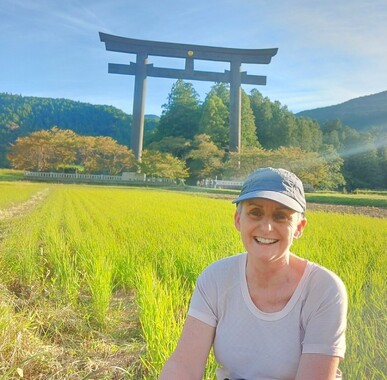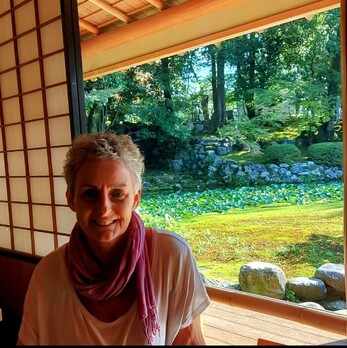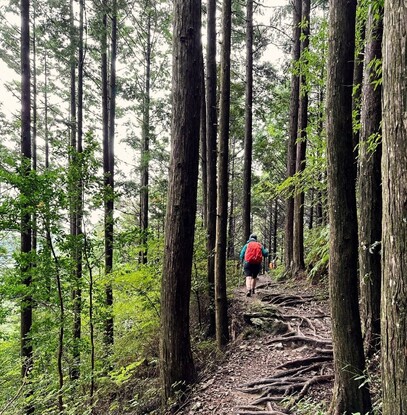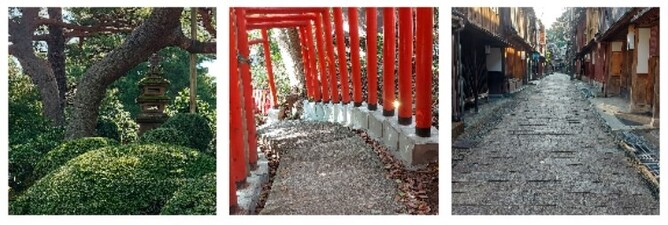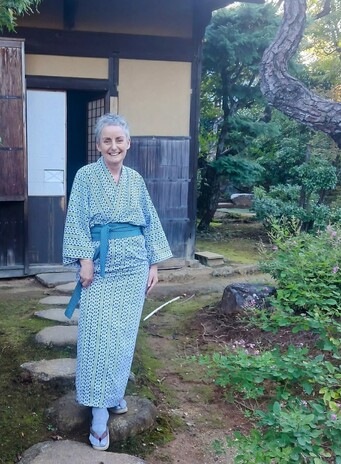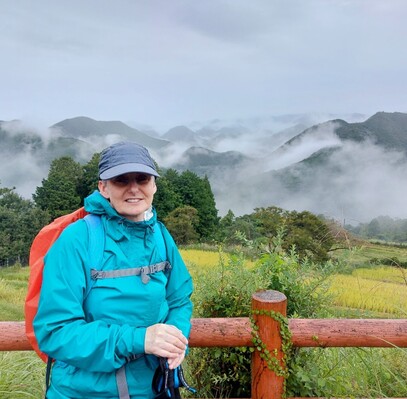After nearly four weeks in Japan, it is at the top of my list of best countries to travel light and travel solo in. Especially solo female travellers.
When you visit Japan, you will experience the exquisite culture where every detail is deliberately perfect. Whether it be the hospitality, the food, the gardens, the shrines and temples, the transport and the accommodation – it is all done with the most incredible attention to detail.
Japan is a feast for all your senses, and it can be done with a light carry-on bag. After three and a half weeks there, let me explain how I did it with my five top reasons.
#1 - Japan is safe to travel solo in.
If you’ve read my travel memoir, ‘Dare to Travel Solo: Exploring Croatia and Italy with a light carry-on bag and a ton of determination’, you’ll know that safety was my initial reason for travelling light. I needed to keep my gear with me and not be mugged. Losing my bag would be losing all my essentials. As a solo female traveller, I cannot stress enough how important my personal safety and luggage safety was.
What a joy it was to feel so safe in Japan. I never once felt at risk in cities or villages. Admittedly, there are always a lot of people around, so you never feel alone. But I absolutely loved walking around at night in the dark. It’s not something I would normally do when travelling alone, so it was a novelty.
Following my gut instinct is my biggest guide for safety, and it was never raised…except for the wildlife!
Teatime at the Kenroku-en gardens, Kanazawa.
Keeping yourself safe in the wilderness in Japan.
Thankfully I’d been warned by the hiking company about snakes. In hindsight, next time I will pack leg gaiters to protect against snake bites. We did see a number of snakes (including the venomous Japanese pit viper or mamushi) on the trails. I was also extremely grateful to have Australians who were incredibly knowledgeable about snake behaviour and what to do when you see one.
Keeping calm was not in this Kiwis nature – so any sightings were welcomed with a scream, levitating, then freezing on the spot. The mamushi sighting had my Australian hiking friend grabbing my collar and pulling me back slowly away from the upright, ready-to-strike, snake. Unfortunately, my luggage allowance doesn’t allow for carrying Australian companions in it! Oh, I wish!
I wasn’t expecting bears to feature in the wild. But a large number of hikers wearing Christmas sounding bells on their bags or clipped to their hiking pants, saw that people were taking this risk seriously. I opted for non-stop chatter in the areas where there had been recent sightings. I now get transported back to the Japanese wilderness when I hear little bells chiming - and with Christmas approaching – this could be quite triggering!
Ringing the large school-bell type bear bells, that hung from posts was entertaining, although my vigorous ringing deafened a few people. I’m not sure if they carry bear spray over there, like they do in other parts of the world, but if it’s advised I would next time.
Insects were another issue. In hindsight I probably should have worn long hiking pants instead of shorts, but the insect repellent worked fine. I bought that in Japan rather than adding to my carry-on liquid allowance.
Into the woods - nature at its best. Kumano Kodo.
#2 - Transportation in Japan is extremely reliable and well-organised.
The Japanese are known for their precision and efficient processes. This makes the transportation system world-class. Trains and busses run like clockwork. With some small hiccups, I mastered the ticket buying process. The crowds in the station were pretty overwhelming at times. I used my old trick of visiting the station either the day or morning before to check the layout. This eased my mind a lot.
The speed of the trains was phenomenal. I loved that ground transport was just as time efficient as plane travel. Probably better, as I didn’t need to get to an airport in plenty of time, the train stations are all central, and I love seeing the countryside whizz by.
Travelling with a light bag made it very easy for getting through train stations, and boarding trains when time was a bit tight. And on one occasion, when I hopped on the wrong train carriage and looked like a complete travel novice, I walked up and down the train, through multiple carriages, looking for my seat. Doing this with my day bag was no issue at all.
I didn’t need to strap my bag into the luggage compartments at the front and rear of the train carriage. It just stayed with me at all times.
Looking relaxed waiting for the train (10 minutes earlier I wasn't!)
The transport gives you so many options.
I'd originally booked to stay in Kyoto for a week, but after two days I knew that this was going to be too long for me. I needed a less crowded spot.
The train systems allowed me to check out many possible destinations for four nights. I opted for Kanazawa, a city known for its edo-period period architecture, a preserved Samurai area and one of the top gardens in Japan.
This is also the joy of travelling solo - I didn't need to ask anyone's permission, but I did make sure I let a few people know where I was heading. Being flexible and able to change plans at a whim is such a plus.
Sightseeing in Kanazawa.
#3 - Group hikes are a great way to see rural Japan and meet others.
I like to mix up solo travel or alone time, with time spent with others. Joining a self-guided group of hikers was the tonic I never knew I needed. It was a mix of couples and solo travellers – solo for a whole variety of reasons.
I walked the Kumano Kodo and the Nakasendo Way through an Australian company, Raw Travel (not affiliated). They organised me into a group of others, and sorted the accommodation, meals and the route.
Their app was a great help in keeping to the route and seeing places of interest nearby. We stayed at local accommodation where the food was incredible (including the lunch boxes) and the hospitality was outstanding. They also transported our excess luggage between the accommodation, so we only needed to carry what we needed for the hike.
I had originally tried booking the walk as an independent traveller, but the demand on accommodation made this quite challenging. In hindsight, knowing the terrain, the wildlife, and the remoteness, I’m incredibly relieved that Raw Travel could fit me in. And I think I may have to continue with this style of travel. Yes, it costs more, but you’re paying for the convenience and ease. And sometimes as a solo traveller you just want someone else to sort things out!
The friendships and connections that developed over the weeks of hiking were incredible. Meeting complete strangers and leaving as friends is priceless.
The onsen experience became a ritual in self-care and much needed relief for tired legs. The initial awkwardness of bathing naked in front of other women lasted about one minute. It became perfectly normal. If the onsens were open at 6am, I would dash down before breakfast and the days’ hike. I miss them so much.
I loved seeing rural and village life at a walking pace. We passed shrines, gates, temples, homes, gardens, fields, teahouses, people, and animals. There were rarely any crowds, so we had these incredible places to ourselves.
Stunning scenery on the Kumano Kodo and Nakasendo Way.
My hiking wardrobe
I wore pretty much the same gear every day.
Shorts
Merino ¾ leggings in case it was cooler.
A synthetic top (next time I’ll stick with merino) which needed a quick wash each night but was always dry by morning.
A long-sleeved merino tee
A merino buff
Hiking boots
Merino toe socks
Merino hiking socks
Sunglasses & cap, and
My trusty hiking poles
My hiking bag also contained:
A puffer jacket
A raincoat
A first aid kit
Insect repellent
Sunscreen
Plenty of water
Spare socks
A torch
A power bank, and
Our pre-packed lunch.
In my luggage that was sent on in my 12L compactible day bag was:
Sleepwear
Toiletries & medication
Swimwear
Two merino tees
A pair of casual pants
A dressier scarf, and
Underwear.
Every day after hiking, we would have an onsen and get dressed in our Yukata. We wore it for dinner and breakfast. I really didn't wear any other clothes during the evenings while hiking.
What would I pack differently next time?
I'd probably swap out hiking shorts for hiking trousers. They just offer better protection from insects and leeches.
And I would leave the synthetic tee at home. It needed washing every night, and offered no warmth at all when you stopped walking.
Other than that, I'd take everything else.
Post and pre-hiking attire!
Packing carry-on for a hiking holiday.
It’s really important to know what activities you are doing for your trip. The activities will dictate what you pack. And while you can do the mix and match, and layers, at the end of the day sometimes you just have to pack an outfit for a special occasion or activity.
Hiking meant I needed a decent raincoat, hiking poles, hiking boots, and hiking clothing. Always check with local websites as to what equipment is needed. We got an extensive list from our hiking company, Raw Travel. In New Zealand we have planmywalk.nz for planning for NZ hikes.
It was a pretty minimal packing, but even then, it was 6.5 kilos (14lbs) of gear I packed as carry-on. I broke one of my rules – wear your heaviest shoes on the flight - and packed my hiking boots in my bag, which definitely added to the weight and bulk. On the flight home I wore the hiking boots as I maxed-out on the carry-on limits after a wee shopping spree!
I was fully prepared to check in a bag with my hiking poles in them, but for each flight I checked whether they would be OK. I’m wondering if the fact that they folded down to about 40cm long and fitted in my day bag they weren’t seen as a risk. But I will always pack ready to check the poles in, and pack accordingly.
On the way over, I had the poles in the smaller collapsible day bag with a couple of items I could easily replace if the luggage got lost. On the way home, lost luggage would be less of an issue than when you’re travelling, so I had my main day bag ready to be checked in. It weighed 7 kilos (15.5lbs) and my smaller bag/personal item weighed 3 kilos (6.5lbs)… a grand total of 10 kilos (22lbs)!!!
Packing light for the weather in Japan
I visited Japan in October, the beginning of autumn/fall. My sister had been there a week earlier and messaged me about the sweltering weather. By the time I got there, the temperatures were dropping. Much like New Zealand, seasons can change rapidly, but they also have four seasons in one day. With my NZ experience I pretty much knew I needed to pack for any kind of weather.
Layers were essential, and excellent outer layers were vital for hiking in all sorts of weather. Our one and only wet day hiking was on our first day on the Kumano Kodo. It was torrential, and we were soaked through. When we stopped for lunch and waiting for our accommodation to open, we sat in a shelter. It got cold very quickly. I was grateful to have my long-sleeved merino in my bag and my puffer jacket to add as a layer.
I was also grateful for remembering to pack the contents of my pack in a black rubbish bag. Even with a pack cover, water was still able to get into the bag. But with the rubbish bag, everything was dry and those toasty warm layers made my life so much nicer.
I guess, this is all a good reminder to check weather forecasts and local weather, and to also be prepared for any weather event.
Dressed & packed for all weather.
#4 - The Japanese people are always willing to help.
After two weeks of group travel, I didn’t really feel like a solo traveller. One of us would always know the answers, knew the right direction, knew the right platform to be on, knew how to handle snakes. Now I was back to being on my own. And I missed my hiking buddies.
Coming out from the wilderness and group travel to the full-on city madness of Kyoto was a culture shock. We’d previously enjoyed shrines and temples with only a handful of others around. In Kyoto there were thousands. Navigating my way through the chaos was a jolt back to reality. But the friendliness and helpfulness of the Japanese people is incredible. Even with language barriers they won’t shy away from not assisting you.
The times I needed the most assistance was with train travel – both getting tickets and finding the train. Station staff at the counters and on the ground were extremely helpful at steering me in the right direction. Fellow travellers were also always happy to assist – if they themselves knew where they were going. Often it was a case of the blind leading the blind!
Ticket machines were fairly easy to follow if there was an English button. But on the odd occasion where I couldn’t see the English button I decided to guess – this resulted in me trying to buy a tour group ticket for 20 people into some gardens. Fortunately, a woman behind me could see that I was just making it up and hoping for the best and came to my aid.
And thank goodness for Google Translate! It made light work for getting help, directions, or having conversations.
On a quiet hiking rest day when I was doing my own thing for a few hours, I had a delightful exchange with a local café owner who wanted to know about New Zealand. Through Google Translate and my trusty hand signals we talked about the geographical similarities between the two countries – the volcanoes (I showed her a picture of Mt Taranaki that looks like Mt Fuji), the earthquakes, the shape of the countries and how that impacts the similar weather patterns we both experience. I love having connections like this that go beyond the usual hello and goodbye.
I used Google Translate on many occasions, but the best feature (new to me) was holding your camera over the words and the translation came up. This was particularly good with menus and checking ingredients.
#5 - Dining alone is not uncomfortable in Japan.
The two weeks I had hiking was an incredible introduction to Japanese cuisine. We were spoilt rotten with the choices, the tiny bowls of different tastes, and the number of small dishes at each meal was extraordinary. Some fellow hikers were a lot more knowledgeable about the flavours used and it was quite an education I received. So, when I came to eating out alone, I was quite adventurous in ordering multiple dishes, many of which I was familiar with.
Now I’m home, I have found with one small sip of miso soup, I’m transported back to Japan. I’m drinking miso as I write this!
I had no qualms eating out alone in Japan. I was often seated at a bar overlooking the kitchen or looking out the window. I was not alone in eating by myself, with many locals also by themselves. I had many conversations with my neighbouring diners, which I thoroughly enjoyed.
I got used to ordering at the machine outside the restaurants. The first time I was very confused and watched how a few others did it before trying it myself. A staff member spied my hesitancy and helped me out. From there on, I was a pro.
I didn’t need to bring any special evening outfits. I found most restaurants were quite casual in style, so I fitted right in.
I can’t wait to go back to Japan.
There’s no better recommendation for a country than wanting to go straight back. With more hiking trails to explore, I would happily go back and see new places in different seasons.
Japan is the perfect country for travelling solo, and I'd definitely do group hikes again. You can read more about why solo travel is so good here.
As for travelling light, with such a great ground transportation system, travelling with a carry-on sized bag is the best way to travel! Find my packing light tips blog here.
Sayonara! Katherine xo
